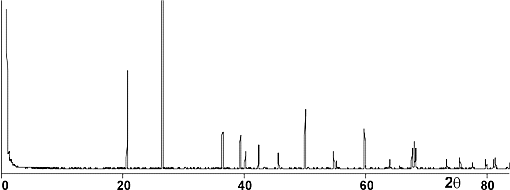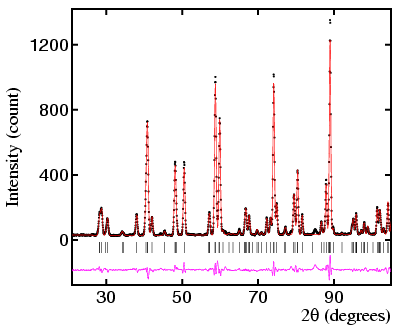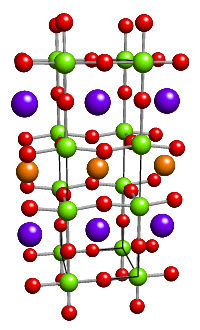 |
Landmarks |
 |
Landmarks |
Landmarks
Detailed discussion will be given during this course on some of the important applications of powder diffraction. To put these into overall context it is instructive at this stage to note the various landmarks of powder diffraction development:
Discovery of Diffraction
This has been discussed earlier.
Identification/JCPDS
During the 1930's Hanawalt, Rinn and Frevel showed that that a powder diffraction pattern could be used as an effective fingerprint for a poly-crystalline material regardless of whether the structure was or was not known. A file of about 1000 common powder diffraction patterns was assembled (originally as a box of 3 × 5 inch cards) and published in 1941. The response by the analytical science community was very positive and the powder diffraction database grew and grew under various organisations to today's PDF (Powder Diffraction File) administered by the International Centre for Diffraction Data (ICDD). A user can collect a diffraction pattern from an unknown powder and then search this database for a match in order to identify the unknown from many thousands of entries. The investigative potential of this facility is obvious and it remains one of the great successes of powder diffraction (click icon below for example).
 (215 kBytes)
(215 kBytes)
Crystallite Size/Strain
When it was realised that the powder pattern contains information other than just the atomic structure, attempts were made to extract other parameters, such as the average size and strain within the crystallites composing a given powder, from the diffraction pattern. Although by the nature of the methods the information was approximate, such methods are a useful complement to other techniques, particularly particle size analysis.
Quantitative Analysis
The intensity of a powder diffraction pattern is proportional, among other things, to the amount of diffracting material present. This is used to good effect in quantitative analysis whereby the weight proportions of several phases within a mixture can be determined from the powder pattern of the mixture. As such it is an investigative technique that stands alongside identification though the results from the latter, when successful, tend to be more clear-cut and trusted.
Powder Camera to Powder Diffractometer
The early days of diffraction used photographic film to record the diffracted X-rays; the diffraction device was appropriately called a camera and the film is sometimes referred to as a two-dimensional detector. An important technical advance was the moving X-ray electronic detector, the early ones being based on the famous Geiger counter. To be effective however they had to be converted into proportional counters, that is the output they generated had to be proportional to the intensity of X-rays detected, unlike the original Geiger counters which were radiation warning devices rather than quantitative devices. As such these detectors could be said to be zero-dimensional (or point) detectors, and to collect a diffraction pattern they had to be mechanically moved around the crystal or powder in an appropriate fashion. However the one really over-riding advantage of electronic detectors was that the diffraction pattern could be fed directly into a computer. Crystallography and diffraction have always been heavy computational subjects and therefore this link was of great initial significance, even though the more modern electronic detectors have increased dimensionality. As such one could here have added computers as a landmark in powder diffraction history, though computers are ubiquitous in all walks of life. The terms powder camera and powder diffractometer refer to any diffraction device that uses photographic film or an electronic detector (respectively) to record the diffraction pattern, though the former are becoming obsolete. The figure below shows the diffraction pattern from quartz as collected by a camera (a Debye-Scherrer camera) and by a modern diffractometer. You might like to look at these and see if you can establish some correspondence between the two.
 |
| Quartz: film output |
 |
| Quartz: modern diffractometer output |
Neutron Diffraction
Since the discovery of the neutron and the fact that neutrons are diffracted by crystals in a similar manner to that with X-rays, neutron sources have been built and furnished with single crystal and powder diffraction equipment at the two main neutron diffraction sites in the UK and in Europe.
However, it was soon realised that there were important differences between neutron and X-ray diffraction; in particular neutron diffraction could give additional information concerning magnetic structure, greater contrast between some elements in the periodic table, and usually greater penetration of radiation through the sample (some of these points will be covered later). These days neutron diffraction is a very important complement to X-ray diffraction.
Rietveld Structure Refinement
In 1969 Rietveld wrote a revolutionary paper in which he discarded the then conventional approach of analysing a powder diffraction pattern primarily in terms of diffraction events (or diffraction peaks as they are termed), and instead analysed the whole pattern simultaneously in which many relevant factors were taken into account regardless of whether they involved the atomic structure of the specimen. In so doing this helped to overcome one of the principal problems in powder diffraction (the congested diffraction peaks in the pattern). Today the method is almost indispensible in structure analysis from powder diffraction data, and will be covered in more detail later (see below example of a Rietveld plot and the refined structure of a high-temperature super conductor which it produced).


Time-Resolved Powder Diffraction
The emergence of intense radiation sources such as synchrotron and neutron sources has greatly contributed to the enormous speed increase with which powder patterns can now be collected. This has enabled powder diffraction patterns to be collected while the specimen is changing, possibly as a result of some imposed condition such as heat-temperature, pressure, gaseous environment, addition of reactants and so on. This mode, known generally as time-resolved powder diffraction, is being used to tell us more about the nature of physical transformations and chemical reactions.
|
© Copyright 1997-2006.
Birkbeck College, University of London.
|
Author(s):
Paul Barnes Jeremy Karl Cockcroft Tony Csoka Martin Vickers |